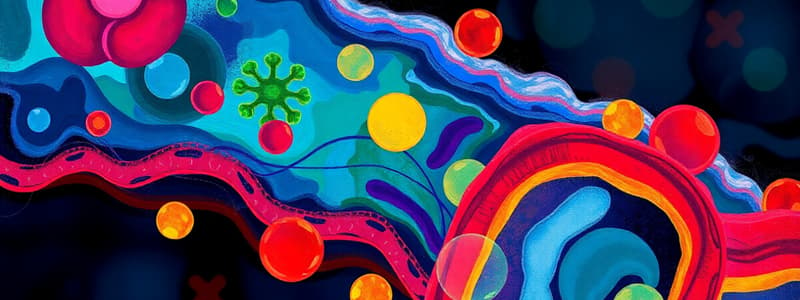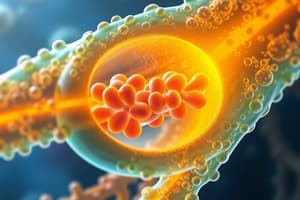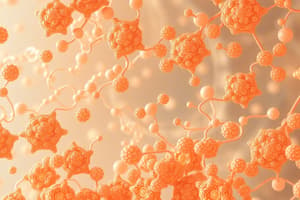Podcast
Questions and Answers
Which lipid type is MOST likely to induce an inverted-conical/positive curvature in a membrane?
Which lipid type is MOST likely to induce an inverted-conical/positive curvature in a membrane?
- A lipid with two saturated fatty acid tails.
- A lipid with one unsaturated fatty acid tail.
- A lipid with one fatty acid tail. (correct)
- A lipid with a large hydrophilic head group.
Which of the following BEST describes the primary function of cholesterol within biological membranes?
Which of the following BEST describes the primary function of cholesterol within biological membranes?
- To maintain membrane rigidity at low temperatures and fluidity at high temperatures. (correct)
- To facilitate the transport of large, polar molecules across the membrane.
- To covalently link membrane proteins to the lipid bilayer.
- To provide a substrate for lipid peroxidation.
What is the MOST direct effect of an increase in 2,3-BPG levels in erythrocytes?
What is the MOST direct effect of an increase in 2,3-BPG levels in erythrocytes?
- Increased bicarbonate formation in plasma.
- Decreased oxygen affinity of hemoglobin. (correct)
- Increased oxygen affinity of hemoglobin.
- Decreased carbon dioxide binding to hemoglobin.
In erythrocytes, which metabolic pathway is MOST critically dependent on the function of the pentose phosphate pathway (PPP)?
In erythrocytes, which metabolic pathway is MOST critically dependent on the function of the pentose phosphate pathway (PPP)?
Which mechanism is MOST responsible for erythrocytes' reliance on anaerobic glycolysis as its primary energy source?
Which mechanism is MOST responsible for erythrocytes' reliance on anaerobic glycolysis as its primary energy source?
Which of the following is NOT a known function of reactive oxygen species (ROS) or reactive nitrogen species (RNS) in biological systems?
Which of the following is NOT a known function of reactive oxygen species (ROS) or reactive nitrogen species (RNS) in biological systems?
During inflammation, respiratory burst in neutrophils is a critical process for pathogen elimination. Which enzyme is MOST directly responsible for initiating this burst?
During inflammation, respiratory burst in neutrophils is a critical process for pathogen elimination. Which enzyme is MOST directly responsible for initiating this burst?
Which scenario would MOST likely trigger increased protein degradation via the ubiquitin-proteasome pathway?
Which scenario would MOST likely trigger increased protein degradation via the ubiquitin-proteasome pathway?
What would be the MOST direct effect of inhibiting autophagy in a cell?
What would be the MOST direct effect of inhibiting autophagy in a cell?
In cell signaling, what distinguishes endocrine signaling from paracrine signaling?
In cell signaling, what distinguishes endocrine signaling from paracrine signaling?
Which characteristic is LEAST likely to be associated with a ligand that binds to an intracellular receptor?
Which characteristic is LEAST likely to be associated with a ligand that binds to an intracellular receptor?
Following ligand binding, which event typically occurs FIRST in a G-protein coupled receptor (GPCR) signaling pathway?
Following ligand binding, which event typically occurs FIRST in a G-protein coupled receptor (GPCR) signaling pathway?
What is one major difference between receptor tyrosine kinases (RTKs) and G-protein coupled receptors (GPCRs)?
What is one major difference between receptor tyrosine kinases (RTKs) and G-protein coupled receptors (GPCRs)?
What is the MOST direct consequence of activating phospholipase C (PLC) in a cell?
What is the MOST direct consequence of activating phospholipase C (PLC) in a cell?
Which of the following ECM components provides resistance to compression in cartilage?
Which of the following ECM components provides resistance to compression in cartilage?
Which of the following BEST describes the role of integrins in the extracellular matrix (ECM)?
Which of the following BEST describes the role of integrins in the extracellular matrix (ECM)?
Which of the following is MOST directly associated with Junctional Epidermolysis Bullosa (JEB)?
Which of the following is MOST directly associated with Junctional Epidermolysis Bullosa (JEB)?
Which cytoskeletal component primarily utilizes the motor protein dynein for intracellular transport?
Which cytoskeletal component primarily utilizes the motor protein dynein for intracellular transport?
What is the MOST direct and immediate consequence of inhibiting the sodium/potassium ATPase in a neuron?
What is the MOST direct and immediate consequence of inhibiting the sodium/potassium ATPase in a neuron?
Which function is MOST directly facilitated by SGLT1 in intestinal cells?
Which function is MOST directly facilitated by SGLT1 in intestinal cells?
Which description BEST characterizes the active transport mechanism of the gastric H+/K+ ATPase?
Which description BEST characterizes the active transport mechanism of the gastric H+/K+ ATPase?
Which event is MOST likely to occur following the phosphorylation of Rb protein?
Which event is MOST likely to occur following the phosphorylation of Rb protein?
What is the MOST direct role of p21 in cell cycle regulation?
What is the MOST direct role of p21 in cell cycle regulation?
During heme synthesis, which metal ion is directly incorporated into protoporphyrin to form heme?
During heme synthesis, which metal ion is directly incorporated into protoporphyrin to form heme?
Which effect is MOST directly associated with increased carbon dioxide levels in the blood?
Which effect is MOST directly associated with increased carbon dioxide levels in the blood?
To analyze a protein via Edman degradation, what is the MOST important requirement?
To analyze a protein via Edman degradation, what is the MOST important requirement?
Which process will MOST likely occur initially when a cell is exposed to oxidative stress, leading to lipid peroxidation?
Which process will MOST likely occur initially when a cell is exposed to oxidative stress, leading to lipid peroxidation?
Which function is MOST specifically associated with fibronectin in the extracellular matrix?
Which function is MOST specifically associated with fibronectin in the extracellular matrix?
The class of membrane transport proteins known as "ionophores" function by which mechanism?
The class of membrane transport proteins known as "ionophores" function by which mechanism?
Which characteristic is MOST likely to be observed with a mutation affecting the chloride channel, CFTR?
Which characteristic is MOST likely to be observed with a mutation affecting the chloride channel, CFTR?
What is the MOST direct reason to use pulse oximetry in evaluating oxygen transport?
What is the MOST direct reason to use pulse oximetry in evaluating oxygen transport?
Which of the following best describes the role of the enzyme lactonase in the pentose phosphate pathway?
Which of the following best describes the role of the enzyme lactonase in the pentose phosphate pathway?
Which outcome is MOST directly linked to increased levels of ROS in endothelial cells that impacts vasodilation?
Which outcome is MOST directly linked to increased levels of ROS in endothelial cells that impacts vasodilation?
Which mechanism is LEAST involved in cellular protection against oxidative damage?
Which mechanism is LEAST involved in cellular protection against oxidative damage?
What is one of the MOST significant INITIAL events after a ligand binds to a receptor tyrosine kinase (RTK)?
What is one of the MOST significant INITIAL events after a ligand binds to a receptor tyrosine kinase (RTK)?
Which outcome is MOST directly associated with activation of the enzyme adenylyl cyclase?
Which outcome is MOST directly associated with activation of the enzyme adenylyl cyclase?
Which function is MOST facilitated by glycosaminoglycans (GAGs) in the ECM?
Which function is MOST facilitated by glycosaminoglycans (GAGs) in the ECM?
Which characteristic is MOST likely associated with Osteogenesis Imperfecta (OI)?
Which characteristic is MOST likely associated with Osteogenesis Imperfecta (OI)?
Taxanes, such as paclitaxel, are chemotherapeutic agents that disrupt microtubule dynamics. What is the MOST likely direct effect of paclitaxel on cell division?
Taxanes, such as paclitaxel, are chemotherapeutic agents that disrupt microtubule dynamics. What is the MOST likely direct effect of paclitaxel on cell division?
Which effect will MOST likely happen in a cell with high levels of cyclin-CDK complexes?
Which effect will MOST likely happen in a cell with high levels of cyclin-CDK complexes?
Which outcome is MOST directly associated with increased p53 activity in a cell?
Which outcome is MOST directly associated with increased p53 activity in a cell?
Flashcards
Laminin
Laminin
Cross-shaped molecule held by disulfide bonds, requires calcium.
Non-Fibrillar Collagen
Non-Fibrillar Collagen
A mesh-like structure composed of repeating glycine-proline-hydroxyproline.
Integrin
Integrin
Linkage of epithelium to basement membranes, within hemidesmosomes.
Fibrillar Collagen
Fibrillar Collagen
Signup and view all the flashcards
Glycosaminoglycans (GAGs)
Glycosaminoglycans (GAGs)
Signup and view all the flashcards
Hyaluronan
Hyaluronan
Signup and view all the flashcards
Aggrecan
Aggrecan
Signup and view all the flashcards
Bohr Effect
Bohr Effect
Signup and view all the flashcards
Oxygen-binding proteins
Oxygen-binding proteins
Signup and view all the flashcards
Pentose Phosphate Pathway
Pentose Phosphate Pathway
Signup and view all the flashcards
Inflammation
Inflammation
Signup and view all the flashcards
Lipid Peroxidation
Lipid Peroxidation
Signup and view all the flashcards
Cellular defenses
Cellular defenses
Signup and view all the flashcards
Protein/enzyme regulation
Protein/enzyme regulation
Signup and view all the flashcards
Protein targeting
Protein targeting
Signup and view all the flashcards
Autophagy stages
Autophagy stages
Signup and view all the flashcards
Autocrine, juxtacrine, paracrine, and endocrine
Autocrine, juxtacrine, paracrine, and endocrine
Signup and view all the flashcards
Signaling mediators
Signaling mediators
Signup and view all the flashcards
G-protein
G-protein
Signup and view all the flashcards
ECM General Structure
ECM General Structure
Signup and view all the flashcards
Filaments
Filaments
Signup and view all the flashcards
P-ATPases
P-ATPases
Signup and view all the flashcards
Active Transport
Active Transport
Signup and view all the flashcards
Cell Cycle
Cell Cycle
Signup and view all the flashcards
Study Notes
- Exam breakdown is approximately 57 questions.
- Some questions cross categories, but the closest packet is indicated.
Biological Membranes and Transport
- Six questions are about biological membranes and transport.
- Describe basic structures, assembly & functions of a simple biological membrane.
- Assess the consequences of changes in the membrane components.
- Compare & contrast membrane components and function in terms of membrane fluidity.
- Understand its role as a barrier between environments.
- List cholesterol, lipids, & proteins roles.
- Explain the link between membrane lipids, membrane structures and function.
- Define and explain the role of lipid rafts in signaling.
- Understand how lipid rafts/membrane domains are regulated by lipid composition and interactions.
- Compare and contrast passive and active transport, and explain the roles of components to that transport.
- List types of transport with corresponding provided examples.
- Link transporter type with corresponding ion and activity.
- List factors determining diffusion kinetics, summarizing differences in saturability & kinetics for simple and facilitated diffusion.
- Describe how an electrochemical gradient is generated and its importance in biological systems.
- Compare and contrast resting and action potentials.
- Correlate membrane structures with role in disease development for Parkinson's, Cystic Fibrosis, Menkes & Wilson's diseases.
- Identify the causes and physiological representation for these diseases.
- Regulation, coordination, compartmentalization/partition, and cellular trafficking are roles of biological membranes
- Composition correlates with function and fluidity.
- Shape and fluidity are based on saturated vs. unsaturated fats.
- Lipid rafts have functions and roles for DHA, cholesterol, and sphingolipids.
Understanding Oxygen
- There are nine questions for understanding oxygen
- Evaluate the role of oxygen and oxygen-binding proteins in normal metabolism and disease.
- Describe heme synthesis, heme structure, the role of iron in heme, and the importance of heme to myoglobin and hemoglobin.
- Compare and contrast myoglobin and hemoglobin structure, behavior, localization, and uses.
- Determine functional consequences for changes in form or structure.
- Explain pulse oximetry and its importance to evaluating normal and abnormal oxygen transport.
- Explain the allosteric regulation of oxygen binding to hemoglobin.
- Identify changes to pH (Bohr Effect), CO2 levels, and 2,3-BPG levels.
- Evaluate erythrocyte structure, function, and metabolism.
- List key differences between an erythrocyte and other human cells in terms of cellular structure and contents.
- Summarize the difference between glucose metabolism in erythrocytes compared to other cell types.
- Compare and contrast oxygen and carbon dioxide transport within erythrocytes.
- Explain the role of bicarbonate in carbon dioxide regulation.
- Summarize the roles of the lungs, kidney, tissues, and erythrocytes in CO2 regulation and acid-base balance.
- Explain the importance of the pentose phosphate pathway to erythrocyte function and oxidative phosphorylation.
- Explain the oxidation-reduction reactions in the pentose phosphate pathway.
- Compare the reversible and irreversible steps of this pathway.
- Determine the consequence of loss of function or gain of function changes in the pentose phosphate pathway.
- Hemoglobin and myoglobin synthesis and activity
- Oxygen binding and affinity are key themes
- Hemaglobinopathies: cause and effect relationship
- Allosteric regulation of hemoglobin affinity for oxygen
- Identify effectors and direction of effect
- Additive effects of effectors
Reactive Oxygen Species
- Six questions are about reactive oxygen species.
- Evaluate oxygen free radicals and reactive oxygen species in human metabolism and disease.
- Identify the reactive oxygen's that are generated during normal metabolic processes.
- List ROS & RNOS generated by metabolic processes.
- Summarize the steps involved in lipid peroxidation.
- Critique lipid peroxidation concerning localization and cell consequences.
- Summarize the steps involved in the generation of reactive nitrogen-oxygen species.
- Describe the role of ROS and RNOS in inflammation, phagocytosis, diabetes, and ischemia-reperfusion events.
- Describe the role of ROS and RNOS in vitamin deficiencies.
- Summarize mechanisms of cellular defenses against oxidative damage and the role of vitamin C, vitamin E, GSH, superoxide dismutase, catalase, and copper.
- Lipid peroxidation involves initiation, propagation, and termination.
- There is a link and mechanisms between ROS/NOS and disease.
Extracellular Matrix
- Nine questions are about the extracellular matrix.
- Understand the ECM's general structure and identify the macromolecules within the 2 important layers.
- Define the structure & function of the following ECM components: laminin, non-fibrillar collagen, integrin, nidogen, perlecan, fibrillar collagen, fibronectin, elastin, glycosaminoglycans.
- Explain the structure and function of hyaluronan and aggrecan and identify their role in cartilage structure.
- Compare and contrast different types of cellular junctions in location, function & important adhesion molecules.
- Recognize the clinical presentation of diseases associated with the ECM and cellular junctions and identify the defective component.
- Laminin is cross-shaped and held together by disulfide bonds and requires calcium.
- Integrin's function is linkage of epithelium to basement membranes.
- Elastin molecules are cross-linked and covalently bound.
- Hyaluronan is withstanding compressive force.
- Aggrecan is a major cartilage component
Protein Degradation and Proteolysis
- Six questions are about protein degradation and proteolysis.
- Explain protein/enzyme regulation basics and define domain, motif, half-life, and proteolysis.
- Explain the relationship between protein structure and protein degradation with factors that increase/reduce protein half-life.
- Assess the role of protein targeting and degradation in regulation of cellular processes.
- List five general initiating mechanisms of protein degradation and match them to their corresponding targets.
- Summarize the process of protein degradation with emphasis on the enzymes and steps involved in protein targeting and recognition.
- Identify the role of ubiquitin and explain ubiquitylation process.
- Explain relationship between proteolysis and autophagy.
- Summarize autophagy stages, emphasizing autophagy utilization to eliminate proteasomes.
- Summarize and explain Edman Degradation steps and its role in defining protein sequence.
- Assess causes and consequences of reduced or altered proteolysis.
Cell Signaling Introduction
- Five questions are about cell signaling introduction.
- Summarize basics of cellular signaling and the difference between direct enzymatic activity and mediated enzymatic activity for receptors.
- Compare and contract autocrine, juxtacrine, paracrine, and endocrine signaling.
- Compare and contrast protein-binding ligand models.
- Compare/contrast types of ligands with lipid/water for soluble hormones actions.
- The three major components to all signaling pathways are Ligands, Receptors, Mediators, and alterations can lead to adverse consequences.
- The key features of signaling are Initiation, Propagation, and Termination/Reset.
Cell Signaling Transduction
- Six questions are about cell signaling transduction.
- Identify signaling mediators for a given receptor or pathway, with emphasis on G-coupled protein receptors, inositol triphosphate, integrin signaling, Pl3K & insulin signaling.
- Explain how signal transduction can be collaborative or concomitant.
- Recognize the steps that lead to signal amplification and explain how low levels of ligand can lead to significant biological responses
- Summarize the conceptual framework of coincident, gated, and feedback mechanisms of signal transduction and apply using discussed pathways.
- Assess consequences for changes in the initiation, propagation, or termination/reset of a given pathway from ligands, receptors, mediators or transcription factors.
Cytoskeleton, Pumps, and Channels
- Five questions are about the cytoskeleton, pumps and channels.
- Explain the structures/functions of actin filaments, microtubules, and intermediate filaments in the cell.
- Explain Taxane family (paclitaxel specifically) and Omeprazole mechanisms of action and assess the consequences of treating a cell/organism with these.
- Summarize steps in activation of sodium/potassium pumps, proton pumps, and calcium channels with emphasis on ion movement and consequences of movement.
- Explain the symport activities that enable absorption of glucose in the intestine and the role of sodium/potassium pumps in the process.
- Summarize and explain the consequences of pathogenic variation in SCL5A1.
- Both sodium/potassium and calcium ATPases are P-ATPases
Cellular Homeostasis and Clinical Correlates
- Five questions are about cellular homeostasis and clinical correlates.
- Identify the following molecules and match their activity to specific steps in cell cycle regulation: p53, pRb, p21, E2F and E2F promoter, CHK1 and CHK2, cyclins, CDKs, cyclin/CDK complexes, and INK4 family.
- Assess the consequences of changes in binding at E2F promoter, Rb phosphorylation, cyclin availability, p53 activity, p21 activity, and INK4 family activity.
- Recognize the clinical consequences for changes in cellular components.
- Link changes in signaling with additional disorders & summarize unique features/corresponding disorders including cancer & proteus syndrome.
- Connect condition with pathways or processes altered and identify condition clinical features.
- How transitions work with requirements to progress through from one phase requires necessary components
- Disorders can be simplified by only using class components
- Pay attention to bolded works in past class packets and connections with the disorders from class
Studying That Suits You
Use AI to generate personalized quizzes and flashcards to suit your learning preferences.




